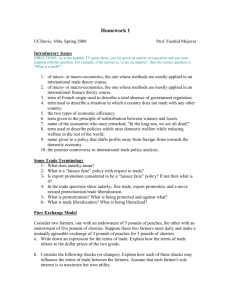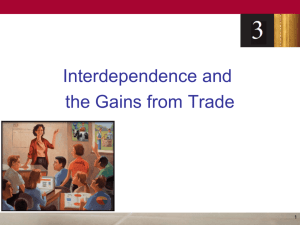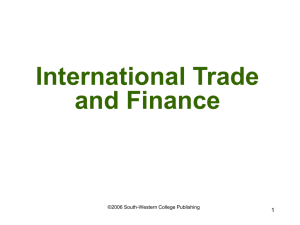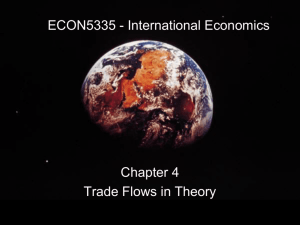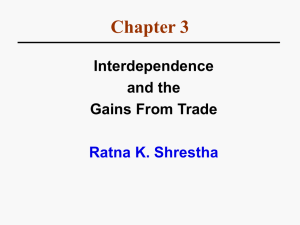Chapter Three
advertisement
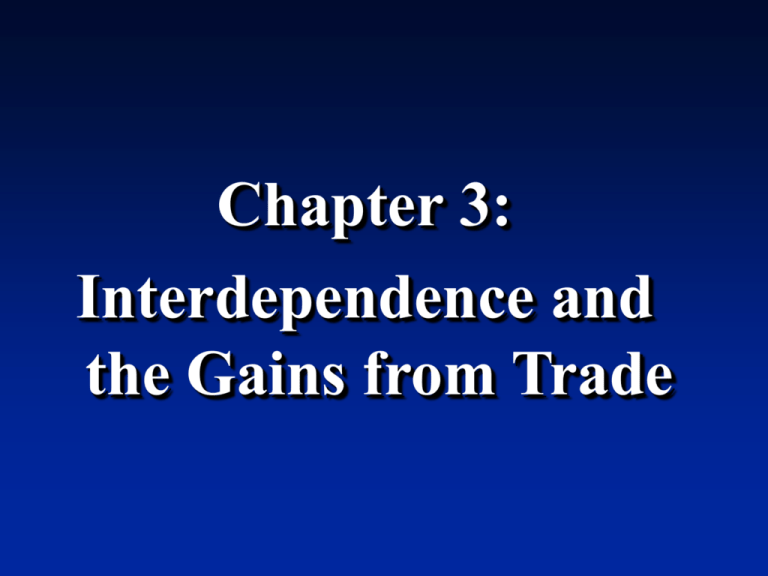
Chapter 3: Interdependence and the Gains from Trade Objective 1. Understand how everyone can benefit from voluntary trade. 2. Learn the meaning of absolute and comparative advantage. 3. Recognize how comparative advantage forms the basis upon which specialization and exchange benefit trading partner. 4. Be able to apply the theory of comparative advantage to real-world situations Opportunity Cost Opportunity Cost of some decision is value of the next best alternative which you have to give up because of the decision Absolute Advantage is the advantage that individual or countries have if they can produce more goods or services with their resources in a given time period than their trading partners Comparative Advantage is the advantage that individuals or countries have if they can produce a good or service at lower opportunity cost than their trading partners Interdependence and Trade Consider your typical day: You wake up to an alarm clock made in Korea. You pour yourself some orange juice made from oranges grown in Florida. You put on some clothes made of cotton grown in Georgia and sewn in factories in Thailand. You watch the morning news broadcast from New York on your TV made in Japan. You drive to class in a car made of parts manufactured in a half-dozen different countries. …and you haven’t been up for more than two hours yet! Interdependence and Trade Remember, economics is the study of how societies produce and distribute goods in an attempt to satisfy the wants and needs of its members. How do we satisfy our wants and needs in a global economy? We can be economically selfsufficient. We can specialize and trade with others, leading to economic interdependence. Interdependence and Trade A general observation . . . Individuals and nations rely on specialized production and exchange as a way to address problems caused by scarcity. Interdependence and Trade But, this gives rise to two questions: Why is interdependence the norm? What determines production and trade? Why is interdependence the norm? Interdependence occurs because people are better off when they specialize and trade with others. What determines the pattern of production and trade? Patterns of production and trade are based upon differences in opportunity costs. A Parable for the Modern Economy Imagine . . . only two goods: potatoes and meat only two people: a potato farmer and a cattle rancher What should each produce? Why should they trade? The Production Opportunities of the Farmer and the Rancher (Table 3-1) Hours needed to make 1 pound of: Farmer Rancher Meat 20 1 Potatoes 10 8 Amount produced in 40 hours (in pounds): Meat 2 40 Potatoes 4 5 Self-Sufficiency By ignoring each other: Each consumes what they each produce. The production possibilities frontier is also the consumption possibilities frontier. Without trade, economic gains are diminished. Meat (pounds) The Farmer’s Production Possibilities Frontier (figure 3-1a) 2 A 1 2 4 Potatoes (pounds) Meat (pounds) 40 20 The Rancher’s Production Possibilities Frontier (figure 3-1b) B 2.5 5 Potatoes (pounds) Meat (pounds) How trade increases the Farmers consumption (Figure 3-2a) A* 3 Farmer’s consumption with trade 2 1 Farmer’s consumption without trade A 2 3 4 Potatoes (pounds) Meat (pounds) How trade increases the Rancher’s consumption (Figure 3-2b) 40 Rancher’s consumption with trade B* 21 20 Rancher’s consumption without trade B 2.5 3 5 Potatoes (pounds) Without Trade: Farmer Rancher With Trade: Production and Consumption Production Trade Consumption Gains from Trade 1 pound meat 0 pounds meat 3 pounds meat 2 pounds meat 2 pounds potatoes 4 pounds potatoes Gets 3 pounds meat for 1 pound potatoes 3 pounds potatoes 1 pound potatoes 20 pounds meat 24 pounds meat 21 pounds meat 1 pound meat 2.5 pounds potatoes 2 pounds potatoes Gives 3 pounds meat for 1 pound potatoes 3 pounds potatoes .5 pound potatoes The Principle of Comparative Advantage Differences in the costs of production determine the following: Who should produce what? How much should be traded for each product? Who can produce potatoes at a lower cost--the farmer or the rancher? Differences in Costs of Production Two ways to measure differences in costs of production: The number of hours required to produce a unit of output. (for example, one pound of potatoes) The opportunity cost of sacrificing one good for another. Absolute Advantage Describes the productivity of one person, firm, or nation compared to that of another. The producer that requires a smaller quantity of inputs to produce a good is said to have an absolute advantage in producing that good. Comparative Advantage Compares producers of a good according to their opportunity cost. The producer who has the smaller opportunity cost of producing a good is said to have a comparative advantage in producing that good. Table 3-3 THE OPPORTUNITY COST OF MEAT AND POTATOES OPPORTUNITY COST OF 1 POUND OF FARMER RANCHER MEAT (IN TERMS OF POTATOES GIVEN UP) POTATOES (IN TERMS OF MEAT GIVEN UP) 2 1/2 1/8 8 Comparative Advantage …so, the Rancher has a comparative advantage in the production of meat but the Farmer has a comparative advantage in the production of potatoes. The Principle of Comparative Advantage Comparative advantage and differences in opportunity costs are the basis for specialized production and trade. Whenever potential trading parties have differences in opportunity costs, they can each benefit from trade. Imports are goods or services produced abroad and sold domestically. Exports are goods or services produced domestically and sold abroad. Adam Smith and Trade In his 1776 book An Inquiry into the Nature and Causes of the Wealth of Nations, Adam Smith performed a detailed analysis of trade and economic interdependence, which economists still adhere to today. David Ricardo and Trade In his 1816 book Principles of Political Economy and Taxation, David Ricardo developed the principle of comparative advantage as we know it today. Should Tiger Woods Mow His Own Lawn? ? ? ? Summary Interdependence and trade allow people to enjoy a greater quantity and variety of goods and services. Summary The person who can produce a good with a smaller quantity of inputs has an absolute advantage. The person with a smaller opportunity cost has a comparative advantage. Summary The gains from trade are based on comparative advantage, not absolute advantage. Comparative advantage applies to countries as well as to people. Graphical Review Production Possibilities Frontiers Meat (pounds) (a) The Farmer’s Production Possibilities Frontier 2 1 0 A 2 4 Potatoes (pounds) Production Possibilities Frontiers Meat 40 (pounds) (b) The Rancher’s Production Possibilities Frontier B 20 0 2.5 5 Potatoes (pounds) Trade Expands the Set of Consumption Possibilities (a) How Trade Increases the Farmer’s Consumption Meat (pounds) Farmer’s consumption with trade A* 3 Farmer’s consumption without trade 2 1 0 A 2 3 4 Potatoes (pounds) Trade Expands the Set of Consumption Meat 40 Possibilities (pounds) (b) How Trade Increases The Rancher’s Consumption 21 20 B* B Rancher’s consumption with trade Rancher’s consumption without trade 0 2.5 3 5 Potatoes (pounds)
